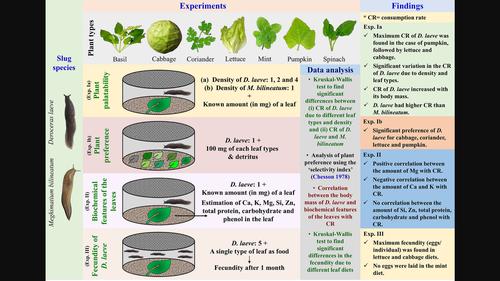当前位置:
X-MOL 学术
›
Ann. Appl. Biol.
›
论文详情
Our official English website, www.x-mol.net, welcomes your feedback! (Note: you will need to create a separate account there.)
Deroceras laeve as a potential agricultural pest in Darjeeling Himalayas, India: Palatability and preference of economically important plants
Annals of Applied Biology ( IF 2.6 ) Pub Date : 2023-09-18 , DOI: 10.1111/aab.12869 Neha Kumari Gupta 1 , Pranesh Paul 1 , Gautam Aditya 1
Annals of Applied Biology ( IF 2.6 ) Pub Date : 2023-09-18 , DOI: 10.1111/aab.12869 Neha Kumari Gupta 1 , Pranesh Paul 1 , Gautam Aditya 1
Affiliation

|
The invasion of the terrestrial ecosystem by gastropods has immense negative impacts on ecosystem functions, health, and agricultural plants. The non-native slug, Deroceras laeve (O. F. Müller, 1774), a recognised agricultural pest in native and invaded regions, was recently reported from the Darjeeling Himalayas, India. We assessed the plant palatability and preference of D. laeve using selected plants being farmed in Darjeeling Himalayas (basil, cabbage, coriander, lettuce, mint, pumpkin leaf, and spinach) by laboratory-based choice and non-choice experiments. Moreover, we evaluated the correlation between different chemical features of the plants with the consumption rate of D. laeve and observed the fecundity of D. laeve reared on different plant diets. The highest consumption rate of D. laeve was observed for pumpkin (12.99 ± 1.33 mg dry mass) and the lowest for mint (1.63 ± 0.13 mg dry mass), with a significant positive correlation between consumption rate and D. laeve body mass (for lettuce: R = .47, p = .0009 and other plant species: R = .52, p = .00004) was observed through the non-choice experiment. Moreover, the consumption rate of the non-native slug, D. laeve, was considerably higher than a controphic slug, Meghimatium bilineatum. In the choice experiment, D. laeve preferred lettuce, followed by pumpkin, cabbage, and coriander, even in the presence of detritus and significantly avoided spinach, mint, and basil. The consumption rate of D. laeve had a significant negative correlation with calcium (R = −.49, p = .003) and potassium (R = −.37, p = .03), and a positive correlation was observed for magnesium (R = .37, p = .03). However, no correlation was observed for zinc, silica, total carbohydrate, protein, and phenol content of the leaves. The highest fecundity of D. laeve was observed in the lettuce and cabbage diet, while no eggs were laid on the mint diet. Hence, the consumption of different leaves, irrespective of physical and chemical features (hairiness, amount of silicon, protein, carbohydrate, and phenol), suitable life history traits, and suitable habitats, may facilitate D. laeve as a potential agricultural pest in the Darjeeling Himalayas, India.
中文翻译:

印度大吉岭喜马拉雅山的一种潜在农业害虫——Deroceras laeve:具有重要经济意义的植物的适口性和偏好
腹足动物对陆地生态系统的入侵对生态系统功能、健康和农业植物产生巨大的负面影响。非本地蛞蝓Deroceras laeve (OF Müller, 1774) 是本地和入侵地区公认的农业害虫,最近在印度大吉岭喜马拉雅山被报道。我们评估了D的植物适口性和偏好。laeve使用大吉岭喜马拉雅山种植的精选植物(罗勒、卷心菜、香菜、生菜、薄荷、南瓜叶和菠菜),通过基于实验室的选择和非选择实验。此外,我们评估了植物的不同化学特征与D消耗率之间的相关性。拉埃夫并观察D的繁殖力。Laeve以不同的植物饮食饲养。消费率最高D.南瓜的Laeve值最高(12.99 ± 1.33 mg 干质量),薄荷最低(1.63 ± 0.13 mg 干质量),消耗率与D之间存在显着正相关。 通过非选择实验观察了Laeve体重(生菜:R = .47,p = .0009 和其他植物物种:R = .52,p = .00004)。此外,非本地蛞蝓的消耗率D。拉埃夫,明显高于营养性蛞蝓Meghimatium bilineatum。在选择实验中,D . Laeve更喜欢生菜,其次是南瓜、卷心菜和香菜,即使存在碎屑,并且明显避免菠菜、薄荷和罗勒。消耗率D.laeve与钙 ( R = −.49, p = .003) 和钾 ( R = −.37, p = .03) 呈显着负相关,与镁呈正相关 ( R = .37, p = .03)。然而,没有观察到叶子中锌、二氧化硅、总碳水化合物、蛋白质和酚含量的相关性。D的繁殖力最高。在生菜和卷心菜饮食中观察到了产卵现象,而在薄荷饮食中没有产蛋。因此,食用不同的叶子,无论其物理和化学特征(毛羽、硅含量、蛋白质、碳水化合物和酚)、合适的生活史特征和合适的栖息地,都可能促进D。印度大吉岭喜马拉雅山脉的一种潜在农业害虫。
更新日期:2023-09-18
中文翻译:

印度大吉岭喜马拉雅山的一种潜在农业害虫——Deroceras laeve:具有重要经济意义的植物的适口性和偏好
腹足动物对陆地生态系统的入侵对生态系统功能、健康和农业植物产生巨大的负面影响。非本地蛞蝓Deroceras laeve (OF Müller, 1774) 是本地和入侵地区公认的农业害虫,最近在印度大吉岭喜马拉雅山被报道。我们评估了D的植物适口性和偏好。laeve使用大吉岭喜马拉雅山种植的精选植物(罗勒、卷心菜、香菜、生菜、薄荷、南瓜叶和菠菜),通过基于实验室的选择和非选择实验。此外,我们评估了植物的不同化学特征与D消耗率之间的相关性。拉埃夫并观察D的繁殖力。Laeve以不同的植物饮食饲养。消费率最高D.南瓜的Laeve值最高(12.99 ± 1.33 mg 干质量),薄荷最低(1.63 ± 0.13 mg 干质量),消耗率与D之间存在显着正相关。 通过非选择实验观察了Laeve体重(生菜:R = .47,p = .0009 和其他植物物种:R = .52,p = .00004)。此外,非本地蛞蝓的消耗率D。拉埃夫,明显高于营养性蛞蝓Meghimatium bilineatum。在选择实验中,D . Laeve更喜欢生菜,其次是南瓜、卷心菜和香菜,即使存在碎屑,并且明显避免菠菜、薄荷和罗勒。消耗率D.laeve与钙 ( R = −.49, p = .003) 和钾 ( R = −.37, p = .03) 呈显着负相关,与镁呈正相关 ( R = .37, p = .03)。然而,没有观察到叶子中锌、二氧化硅、总碳水化合物、蛋白质和酚含量的相关性。D的繁殖力最高。在生菜和卷心菜饮食中观察到了产卵现象,而在薄荷饮食中没有产蛋。因此,食用不同的叶子,无论其物理和化学特征(毛羽、硅含量、蛋白质、碳水化合物和酚)、合适的生活史特征和合适的栖息地,都可能促进D。印度大吉岭喜马拉雅山脉的一种潜在农业害虫。



























 京公网安备 11010802027423号
京公网安备 11010802027423号